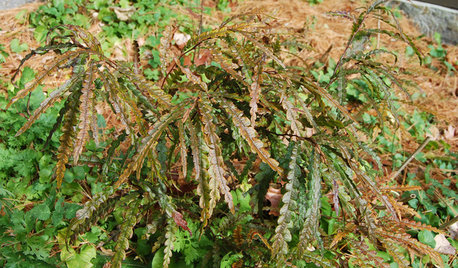Nitrogen
Kuzon
9 years ago
Related Stories

GARDENING GUIDES5 Prairie Wildflowers That Can Heal Your Soil
Get free, organic soil fertilizer with nitrogen-pumping plants that draw pollinators too
Full Story
GARDENING GUIDESNew Ways to Think About All That Mulch in the Garden
Before you go making a mountain out of a mulch hill, learn the facts about what your plants and soil really want
Full Story
GARDENING GUIDESThe Poop Scoop: Enrich Your Soil With Good Old Manure
Get over the ick factor already — this natural super-ingredient for soil has so many benefits, you'll wonder why you ever went chemical
Full Story
GARDENING GUIDESGreat Design Plant: Comptonia Peregrina
Though not a fern, sweet fern sure smells sweet and thrives in tough spots where many shrubs and ferns cannot
Full Story
GARDENING FOR BUTTERFLIESGreat Design Plant: Purple Prairie Clover
Bees and butterflies and color, oh my! This cheery native perennial will energize your landscape
Full Story
SUMMER FRUITS AND VEGETABLESSummer Crops: How to Grow Beans
Grow your own beans for amazing variety and healthy, convenient produce all summer
Full Story
GARDENING GUIDESGet on a Composting Kick (Hello, Free Fertilizer!)
Quit shelling out for pricey substitutes that aren’t even as good. Here’s how to give your soil the best while lightening your trash load
Full Story
GARDENING GUIDESGarden Myths to Debunk as You Dig This Fall and Rest Over Winter
Termites hate wood mulch, don’t amend soil for trees, avoid gravel in planters — and more nuggets of garden wisdom
Full Story
FRONT YARD IDEASBefore and After: Front Lawn to Prairie Garden
How they did it: Homeowners create a plan, stick to it and keep the neighbors (and wildlife) in mind
Full Story
GARDENING GUIDESTackle Weeds the Natural Way
Instead of dousing your yard with chemicals to wipe out weeds, let time and nature work their magic via smothering and solarization
Full StoryMore Discussions






vgkg Z-7 Va
Slimy_Okra
Related Professionals
Norfolk Landscape Architects & Landscape Designers · Wrentham Landscape Architects & Landscape Designers · Accokeek Landscape Architects & Landscape Designers · Essex Landscape Architects & Landscape Designers · Alexandria Landscape Contractors · McKinney Landscape Contractors · Salem Landscape Contractors · Alamo Landscape Contractors · El Reno Landscape Contractors · Muttontown Landscape Contractors · Wayland Landscape Contractors · San Pablo Landscape Contractors · Cleveland Driveway Installation & Maintenance · Riverside Driveway Installation & Maintenance · Lake Forest Driveway Installation & Maintenancedigdirt2
loribee2
jctsai8b
Hermitian
nc_crn
Hermitian
galinas
elisa_z5